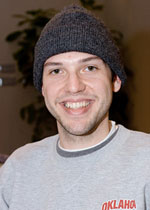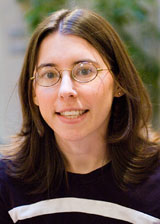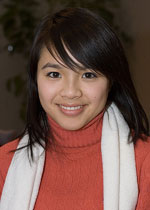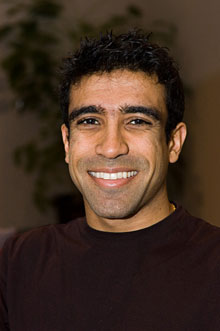India Study Tour Journal
Eight Johns Hopkins Bloomberg School of Public Health students will spend two weeks in India experiencing the culture and using their educations to assist and learn from established public health programs.

Back: Sachin Jain, Kyden Creekpaum, Sachin Patel
Front: Leah Sirkus, Jenny Truong, Yung-Ting Kung, Lindsay Kim
Not Pictured: Stacie Waldman
The student group will do mostly observational work at the Aravind Eye Hospital in Madurai through January 9. The Aravind Hospital features an eye care program where staff go into rural villages, find individuals who need eye surgery, load them onto buses and bring them back to their modern surgical unit where expert surgeons do 4-minute cataract surgeries. This program was recommended by Alfred Sommer, MD, MHS, dean emeritus, and James Tielsch, PhD, MHS, a professor of International Health.
In Delhi, the students will work with SHARAN, a non-governmental organization that provides healthcare, detoxification and rehabilitation to drug users of all ages, including young children and adult IV drug users, in an environment fraught with inadequate housing, HIV/AIDS, poor water and sanitation and illiteracy.
The students-Kyden Creekpaum, Sachin Jain, Lindsay Kim, Yung-Ting Kung, Sachin Patel, Leah Sirkus, Jenny Truong and Stacie Waldman-share their adventures from abroad. This is their study tour journal.
Tuesday, January 24, 2006
By Jon Creekpaum

Thank you all for joining us on our trip! It is wonderful to be back in the United States. We learned a tremendous amount in a short time, and were all challenged by the commitment and passion of our fellow public health workers in India, especially in the face of hardships and scant resources.
In the first part of our trip, our group’s study of the Aravind Eye Hospital System left us with a profound impression of their beneficent yet realistic philosophy, their bold and unapologetic innovation and their indomitable resolve always to do more, to do better and to do it more efficiently.
While in Delhi, we came face to face with the reality of abject poverty in a developing world mega-city. Those left behind in the economic evolution still confront formidable barriers to health and the pursuit of happiness. Fettered by drug dependence, the already disadvantaged would have little hope without a helping hand from evidence-based interventions like those run by the Sharan Project and our own Dr. Michael Sweat. We were also encouraged by the wide variety of well-managed projects we encountered at MAMTA, a maternal and child health NGO, as well as at the Safdarjang Hospital Adolescent Healthcare Network.

Monday, January 16, 2006
By Lindsay Kim
Today is our last day in India before a full day of traveling back to the United States. After a weekend of our classmate Pritika's wedding events, we spent the morning at Sachin Jain's uncle's house and savored the sumptuous flavors of Indian home cooking. After we stuffed ourselves full of gobi (cauliflower), aloo (potatoes) and rice, we headed to Safdarjang Hospital, one of Delhi's largest public hospitals, which prides itself on its reputation of turning no patient away. We met Dr. Rajesh Mehta, the coordinator of the Safdarjang Hospital Adolescent Healthcare Network (SHAHN). The Adolescent Clinic is supported by the government of India and the World Health Organization. Children at the Clinic receive comprehensive health care that includes screening for depression and suicide, body-image perception, nutrition and family and social support. Ensuring confidentiality is an important aspect of SHAHN’s success. We ended our visit with a meeting with Dr. R. N. Salhan, the medical superintendent of Safdarjang Hospital. Salhan discussed the challenges of running the hospital in a fiscally responsible manner while striving for the best patient care.

Saturday, January 14, 2006
By Leah Sirkus
On Friday, Lindsay Kim and I met with the Asian Pacific Bureau Chief of the AIDS Healthcare Foundation. We discussed the HIV situation in India. Currently, 85 percent of HIV transmission is through heterosexual sex, and the epidemic is moving into rural areas. Only 35,000 people are receiving antiretroviral (ARV) therapy in India, a number far below the target of 100,000 set by the WHO 3x5 campaign. The AIDS Healthcare Foundation has set up several ARV treatment clinics in India, and is working to increase the number of AIDS patients receiving ARVs.

Friday, January 13, 2006
By Jenny Truong
Our group of eight members split into smaller teams to pursue our diverse public health interests in Delhi. Stacie, Yung-Ting and I returned to Mamta to observe one of their community-based programs, a program for adolescent peer health educators in one of the slum communities of Delhi. These adolescents are recruited from their communities and trained to advise on reproductive and sexual health issues. We spent time learning about their experiences and they shared with us the challenges of their work, including the difficulties of earning the respect of elders, dispelling myths and misconceptions about health issues and balancing this volunteer work with the need to contribute financially to their families. It was great to be able to spend time with these young men and women and we enjoyed our exchanges with them. They were just as eager to get to know us and inquired about life in America, asking us questions about marriage patterns, sexuality and health issues.
Wednesday, January 11, 2006
By Jenny Truong
Today we visited the Mamta Institute for Mother and Child (www.mamta-himc.org), a non-governmental organization that works on issues related to maternal and child health in India. We met with the organization’s senior advisors and learned about the various networking, advocacy and research branches of the organization. The breadth of Mamta’s activities impressed us all, ranging from studies of masculinity in Uttar Pradesh to the development of sexuality education programs to advocacy for improved census data. One common theme of these activities is the necessity of community support and evidence-based actions, a theme that also surfaced in our experience at the Aravind Eye Hospital.

Wednesday, January 11, 2006
By Sachin Patel
Happy Eid!!! We were surprised to learn that today is a bank holiday in Delhi, meaning that a number of area businesses and organizations were closed. Our preliminary planning had us scheduled to visit Mamta, a maternal and child health advocacy organization centered in Delhi but active throughout India. Unfortunately, a little email miscommunication led to our arrival at Mamta on a holiday when most Mamta staff were absent. Nonetheless, two senior advisors made themselves available to host us for the morning. First, the senior advisors gave us an introductory presentation outlining the mission, values and activities undertaken by the organization, as well as a history of how those elements have changed over the past 15 years. Mamta is an impressive and incredibly productive organization that uses gender-sensitive processes to empower the underserved and marginalized populations. Their activities include everything from advocacy for women's rights to research focused on female adolescent health to income generation programs for poor women and children. Unfortunately, given the absence of most of the organization’s staff due to the holiday, we were unable to make any site visits with Mamta today.
We were, however, very lucky that Mamta's founder, Dr. Sunil Mehra, was available to meet with us for half an hour to answer questions about Mamta and international public health work in general. Mehra is a pediatrician by trade and followed his passion to help children and their mother by founding Mamta in 1990. Since then, he has shepherded the organization through monumental changes in its organization and mission to bring it into the international spotlight as an NGO doing positive work all over the country. Hearing Mehra give us sincere advice and anecdotes about his career path as an NGO leader was indeed inspiring. Interestingly, when we asked what he felt was his most difficult challenge today, he said, "finding good people to work with you." Mamta has met this challenge by offering its workers the opportunity to do the work they want so they can get the experience they personally feel they need, as well as trying to become more competitive with salaries and benefits. He also gave us some rare and invaluable insight into the challenges facing NGOs in maintaining long-term fiscal viability. Since it’s a holiday, we're now off to do a little shopping and then back to Sharan tomorrow.
Tuesday, January 10, 2006
By Sachin Patel
Today was bound to be an exciting day as we were scheduled to visit our first NGO in Delhi—the Sharan Project. Sharan is an organization whose mission is to provide holistic services to the urban poor, particularly those migrants and homeless children who deal with their despair by resorting to drug abuse. Though much of their work deals with IV drug users (mostly males) at risk for or suffering from HIV/AIDS, Sharan hosts a number of projects, ranging from literacy programs in slums to detoxification clinics to litigation to improve the hospital environment for HIV/AIDS patients in India.
Our day began at the YMCA hostel where a contact from the Sharan project met us in the lobby. He led us through Delhi’s new metro system (surprisingly like London's Underground) and used a small army of bicycle rickshaws to take us to Yamuna bazaar, a slum where many of Sharan's activities are centered. We were greeted by Luke Samson, Sharan's director, and graciously treated to a cup of chai while he gave us an overview of Sharan's many projects. Sharan's main office was a surprisingly small room equipped with client tracking charts on the walls, two computers, a printer and a few desks. This office is responsible for tracking the services provided to some 450+ clients.
We first visited the abscess- and wound-care clinic, a small room located next door to the main office. This clinic provides a vital service to low-income IV drug abusers who suffer from serious wound infections at injection sites on their bodies. After the wound clinic, we headed out into the slum to talk with some of Sharan's clients and to visit the parks where many of them can be found actively injecting “a cocktail,” a mixture of buprenorphine (an opiate that can give them a high), diazepam (a sedative) and Avil (an antihistamine to counteract some of the side effects of buprenorphine). We learned that abusers will resort to any means possible, including criminal activity, to gather the 50 rupees they need to buy a cocktail pack from the streets.
We finished the afternoon by visiting a nearby shelter run by Sharan to accommodate their homeless clients during the winter months—a tent equipped with about 60 beds available on a first-come-first-serve basis.
Needing to leave town until later in the week, Samson left us in good hands with Arun, Jimmy and Simon, three dedicated Sharan employees. We'll meet up with them on Thursday to continue further site visits, which we hope will include slums in other parts of Delhi and the drug rehab center run by Sharan.

Monday, January 9, 2006
By Sachin Patel
We made it to Dehli after a few exhausting days of travel in Kerala (including a visit to Kochin, which is home to bustling fish markets and a growing tourism industry) and an 11-hour van ride back to Madurai from Kerala.
Dehli is the third largest city in India, with a population of around 14 million, surpassed only by Mumbai and Kolkata (formerly Calcutta). The moment we stepped off the plane, our senses were filled with the contrasting smells and views that define Dehli. As we disembarked from the plane to the runway, my lungs choked on the thick smog hovering around us. The hustle and bustle of the Dehli airport, host to hundreds of arrivals per day, was a far cry from the tranquility of the Madurai airport, which sees only a handful of flights each week. The YMCA visitor's hostel will serve as our home base while we’re here. Tonight will be low-key, a chance to re-charge before visiting the Sharan Project tomorrow.
Friday, January 6, 2006
By Sachin Patel
Today, we visited a local wildlife sanctuary by boat to see first-hand how locals are trying to preserve Kerala's natural beauty. I get the feeling that the Malayali people appreciate the balance of nature as an integral component of the Kerala population’s longevity. The morning mountain air was surprisingly cold, in stark contrast to the 80-plus-degree heat of Tamil Nadu.
After visiting the sanctuary, it was back on the road again! We bid Periyar farewell and struck out in the van on a mountain path towards Kumarkorum in the backwaters of Kerala that surround Vembanad Lake. Unfortunately, a few of our party battled motion sickness as the van wound through narrow, winding, bumpy roads sandwiched between the mountain wall on one side and the cliffs overlooking valleys on the other. Our driver, Ganesh, has had twenty-two years of driving experience and I'm thankful for each and every one of those years.
We arrived in Kumarkorum safely and soon learned of a local dancer who was to perform a traditional South Indian dance to live tabla music. Before calling it a night, we took the opportunity to enjoy one of the oldest and most revered art forms in the region.
Thursday, January 5, 2006
By Sachin Patel
With our visit to Aravind behind us and with four days to go before our next set of non-governmental organization visits in Dehli, we set off for the state of Kerala. Over the next few days, we'll be visiting the Idukki, Kottayam and Ernakulam districts in south-central Kerala. Our first stop is Periyar, due west of Maduari.
India has two national languages—Hindi and English—but that hardly speaks to the vast linguistic diversity to be found in a country roughly a third the size of the United States but with over three times the population. In Tamil Nadu (where Madurai is located), most people speak the ancient language of Tamil on a daily basis, though schools teach Hindi and English. In Kerala, the culture is Malayali and the language spoken is called Malayalam (altogether different from Tamil). Nobody among the eight of us speak either Tamil or Malayalam, but fortunately, everyone we encountered at Aravind spoke English, so communication wasn't a big barrier. For the next several days, a man named Matthew Joseph will be our traveling companion. Matthew speaks Tamil, Malayalam and English.
When we left for Kerala, our objective was to get some idea of the lives led by people in one of India's many cultures. As we crossed the border from Tamil Nadu to Kerala, we entered a world that was subtly different. The roads were paved, the air a little less polluted and farm land was present as far as the eye could see. Periyar gave us an insight into the farming life that is pursued even up in the mountains. We met Jacob, a local plantation owner with a great fund of knowledge of Periyars major crops. A trek through a lush forest plantation revealed a cornucopia of beautiful crops—pineapple, cinnamon, cardamom, peppercorn, nutmeg, coconuts, cocoa beans, coffee, vanilla, etc.—as well as plenty of animal life (including wood spiders the size of your hand!!). I'm looking forward to seeing more of Kerala these next few days.
Wednesday, January 4, 2006
By Sachin Patel
Today was our last day visiting the Aravind Eye Hospital. We're a bit sad to leave after the past several days. The people we've met at Aravind have been wonderful and gracious hosts, having taken the time to introduce us to the operations of the Aravind system of care. We're particularly indebted to our primary contact, Sanil Joseph, who planned our daily itineraries, which included meetings with top administrators and faculty, site visits, operating room observations and a meeting with the founder of Aravind, Dr. Govindappa Venkataswamy.
Today started with a visit to the portion of the hospital where patients pay for surgeries. We observed cataract surgeries by the renowned Dr. Aravind himself, who is also the current director of the Aravind Hospital in Madurai. The rest of the morning, we met with a number of administrators and volunteers who answered our about the operations of the Aravind Eye Care System. We also visited the eye bank, where thousands of donated eyes are stored before being used for research and training. We also met with Dr. Venkataswamy. It was humbling to hear from a man who has selflessly devoted his life to a cause he believes in. We spent nearly an hour asking him questions about his life, his vision of eliminating needless blindness and his work with Aravind over the past several decades. Meeting Dr. Venkataswamy was inspiring.
Tuesday, January 3, 2006
By Sachin Patel
We visited a number of the satellite clinics today that increase access to the Aravind system of care throughout the state of Tamil Nadu. The system is composed of five tertiary care centers where cataract surgeries ultimately take place. There are a number of secondary care centers where resident ophthalmologists see patients in person and then funnel patients through to tertiary care centers as appropriate. Beyond that, there is a network of primary care clinics where patients usually have their first point of contact with Aravind.
These primary care clinics are remarkable, not only in the quality of the health care staff, but also in the fact that they’ve implemented an advanced telemedicine network. Unlike the secondary care clinics, those for primary care don't have a resident doctor. Instead, rural patients use a webcam and a chatroom over a broadband connection to have live consultations with ophthalmologists elsewhere in the system. This is a truly remarkable set up when you see it live. Imagine what it must be like to grow up in a rural setting and then suddenly be able to talk through the TV to your doctor!
Monday, January 2, 2006

By Jenny Truong
Today, we met with one of the senior administrators of Aravind and discussed the major business tactics, as well as public health principles, behind Aravind’s model of “high-volume and high-quality eye care.” One way that Aravind makes its operation sustainable is to manufacture its own intraocular lenses, suture needles, eye instruments, surgical blades and pharmaceuticals. We toured the facilities and once again were thoroughly impressed. We spent the last part of our sitting in on a board meeting where the progress of the eye-screening camps was reviewed.
Tomorrow, we’ll be traveling by bus to three different branches of the Aravind hospital, a secondary hospital in Theni, the first satellite hospital of Aravind and two other community health centers that provide eye care services. We are all in great spirits and learning a lot.
Sunday, January 1, 2006
By Jenny Truong
One of the components of the Aravind Eye Care System is community outreach by using camp eye screenings at various locations throughout the state at both weekly and monthly intervals. Each camp is led by one lead organizer and receives financial support from a designated sponsor, which can be a large organization or an individual within the community. We were fortunate enough to be able to observe one of these camp eye screenings, which was held in a Hindu temple. The screening area was extremely well organized and split into several different stations: patient intake and registration, preliminary visual acuity testing by trained nurses, more specific testing by doctors, ocular pressure, refraction, counseling for cataract surgery and eye glasses. We watched as a trained staff member carefully cut and fashioned lenses and fit them into the patient’s frames, which are also sold there. The Aravind staff can fill a patient’s prescription by manufacturing the eye glasses by hand at the camp site and deliver a patient’s glasses to him/her within half an hour! The entire camp was very streamlined and each station operated smoothly given the limited availability of trained staff. We spent the rest of the afternoon as tourists, visiting the Meenakshi Temple, the largest Hindu temple in the city. We were fascinated by the architecture and the crowds of people who had traveled far distances to visit.
Saturday, December 31, 2005
By Jenny Truong
Welcome to our online diary! After more than 36 hours of travel, four different airports, a dozen rounds of cards, half a dozen Sudoku puzzles and not nearly enough shut-eye, we arrived in Madurai, the holy city of the southern state of Tamil Nadu. Once we arrived and dropped off our bags at the local hotel, we hit the ground running. Our five-day visit to the Aravind Eye Hospital began with tours of the hospitals and the research centers, where it was very clear that we are walking in the midst of a extremely efficient machine. Later, we met with senior directors to discuss their successful business model. We are left pondering such questions as: How could the United States adapt a model of care such as Aravind's? How can health care be molded to cultural and regional differences? What's the best way for public health professionals to relay information to policy makers and politicians? Happy New Year to all!
